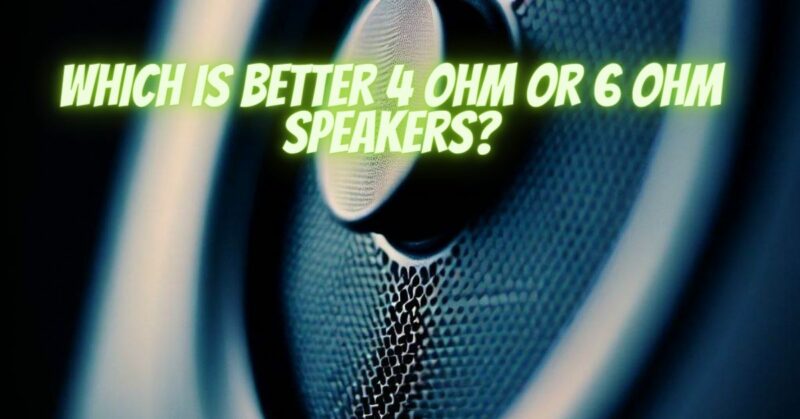When it comes to choosing speakers for your audio system, you’re often presented with various options, including different impedance ratings such as 4 ohms and 6 ohms. But is there an advantage in selecting one over the other in terms of audio quality? In this article, we’ll delve into the characteristics of 4-ohm and 6-ohm speakers and explore whether one offers a quality advantage over the other.
Understanding Speaker Impedance
Impedance is a measure of a speaker’s resistance to electrical current, and it is typically represented in ohms (Ω). Understanding how impedance works is essential when selecting speakers for your audio system:
- Low Impedance (e.g., 4 ohms): Low-impedance speakers have less resistance to electrical current, allowing more power to flow from your amplifier. They can demand more current from the amplifier, potentially delivering higher volume levels.
- Higher Impedance (e.g., 6 ohms): High-impedance speakers have more resistance, which results in a lower demand for current from the amplifier. They tend to be more efficient in converting power into sound.
The Quality Consideration
Now, let’s explore whether one impedance rating provides a quality advantage over the other:
Advantages of 4-Ohm Speakers:
- Power Handling: 4-ohm speakers typically require more current from the amplifier, which can result in higher power handling capabilities. This means they can handle more power without distortion, making them suitable for high-powered audio systems.
- Volume Potential: Due to their lower impedance, 4-ohm speakers can produce higher volume levels when paired with a compatible amplifier. This can be advantageous for those seeking a louder audio experience.
Advantages of 6-Ohm Speakers:
- Stability: 6-ohm speakers tend to present a more stable load to amplifiers, which can be beneficial for certain types of amplifiers, particularly tube amplifiers. The stable load can contribute to smoother and more consistent sound quality.
- Compatibility: Many mainstream audio receivers and amplifiers are designed to work optimally with 6-ohm speakers. Using 6-ohm speakers with such equipment can result in a balanced and efficient setup.
- Efficiency: Higher-impedance speakers can be more efficient in converting power into sound. This means they can produce sound with less energy, potentially resulting in less heat generation and longer amplifier lifespan.
Choosing the Right Impedance
The choice between 4-ohm and 6-ohm speakers depends on your specific audio system, preferences, and amplifier compatibility. Here are some considerations:
- Amplifier Compatibility: Check your amplifier’s specifications and guidelines. Some amplifiers are designed to work best with a particular impedance rating, and using speakers that match this rating can optimize sound quality.
- Power Requirements: Consider the power needs of your system. If you require high volumes and have a powerful amplifier, 4-ohm speakers may be more suitable. If you have a less powerful amplifier, 6-ohm speakers might be a better match.
- Room Size and Listening Environment: Assess the size of your listening space. Larger rooms may benefit from the increased power potential of 4-ohm speakers.
- Sound Preferences: Ultimately, your personal sound preferences play a significant role. Listen to both types of speakers if possible and choose the ones that provide the sound quality you desire.
In the 4-ohm vs. 6-ohm debate, there isn’t a clear-cut winner in terms of audio quality. The choice between these impedance ratings depends on your specific audio system, listening environment, and personal preferences. Both 4-ohm and 6-ohm speakers can deliver excellent sound quality when properly matched with the right amplifier, so take the time to consider your needs and audition different speakers to find the perfect fit for your audio setup.


